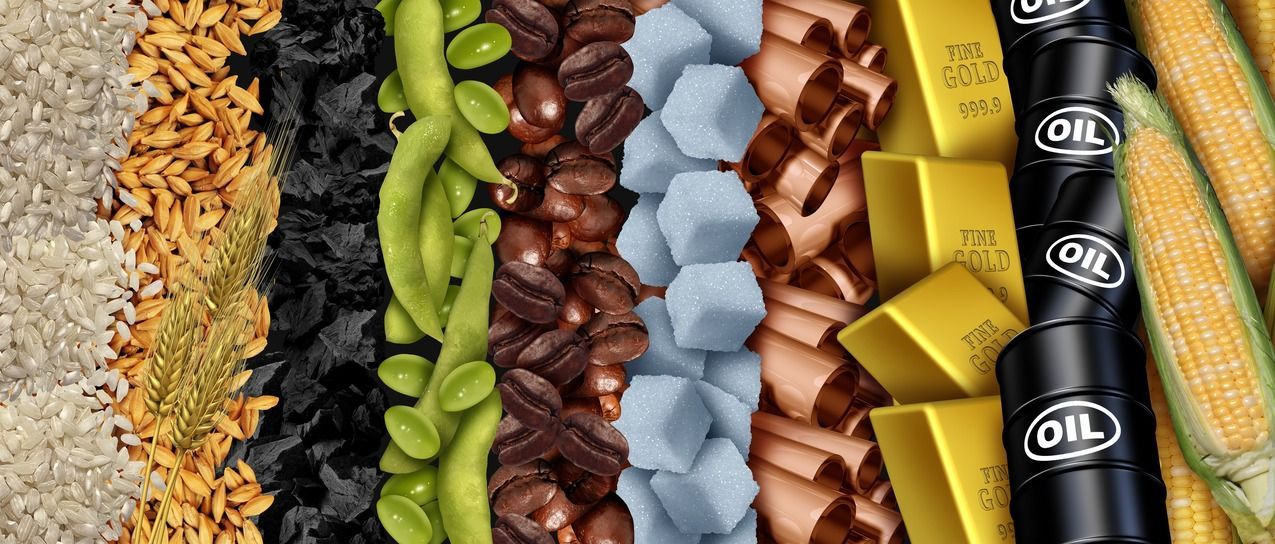Commodities trading involves the buying and selling of raw materials or primary agricultural products. These commodities are standardized and interchangeable with other goods of the same type, making them suitable for trading on various exchanges. Commodities can be broadly categorized into two main types: hard commodities and soft commodities.
Types of Commodities

- Hard Commodities:
- Hard commodities are natural resources that are mined or extracted. They typically include:
- Energy: Such as oil, natural gas, and coal. These commodities are crucial for powering economies and are subject to fluctuations based on geopolitical events, supply disruptions, and changes in demand.
- Metals: Including precious metals like gold and silver, as well as industrial metals like copper and aluminum. These metals have diverse applications, from jewelry to construction, and their prices can be influenced by factors such as mining output and industrial demand.
- Hard commodities are natural resources that are mined or extracted. They typically include:
- Soft Commodities:
- Soft commodities are agricultural products or livestock. They include:
- Grains: Such as wheat, corn, and rice. These staples are foundational to global food supply chains, and their prices can be affected by weather conditions, pest infestations, and government policies.
- Livestock: Including cattle and hogs, which are traded based on market demand for meat products.
- Other Agricultural Products: Such as coffee, sugar, and cocoa, which are subject to seasonal variations and trends in consumer preferences.
- Soft commodities are agricultural products or livestock. They include:
Trading Mechanisms
- Spot Market:
- In the spot market, commodities are bought and sold for immediate delivery. Prices are determined by current market conditions, and transactions occur “on the spot.” This market is essential for those who need immediate access to physical commodities.
- Futures Market:
- Futures contracts are agreements to buy or sell a specific quantity of a commodity at a predetermined price on a future date. This market allows traders to hedge against price fluctuations or speculate on future price movements. For example, a farmer may sell futures contracts to lock in a price for their crop before harvest, while a trader might buy those contracts to profit from anticipated price increases.
- Options Market:
- Options give traders the right, but not the obligation, to buy or sell a commodity at a specified price before a certain date. This provides flexibility and can be used to manage risk. For instance, a trader who anticipates price volatility might purchase options to protect their investments without committing to a full futures contract.
- Exchange-Traded Funds (ETFs):
- ETFs are investment funds that track the performance of a specific commodity or a group of commodities. They offer a way for investors to gain exposure to the commodities market without directly trading physical commodities. ETFs can be an attractive option for those looking to diversify their portfolios while minimizing the complexities of direct trading.
Key Strategies for Commodities Trading
- Fundamental Analysis:
- Traders analyze supply and demand factors, weather conditions, geopolitical events, and economic indicators that can influence commodity prices. Understanding these fundamentals helps in making informed trading decisions. For example, a drought in a major agricultural region can lead to reduced crop yields, driving prices higher.
- Technical Analysis:
- This involves analyzing price charts and using indicators to identify trends and patterns. Technical analysis can help traders determine entry and exit points for their trades. Common tools include moving averages, Relative Strength Index (RSI), and Bollinger Bands, which help in predicting future price movements based on historical data.
- Diversification:
- Diversifying a commodities portfolio can help mitigate risk. Traders may choose to invest in a mix of hard and soft commodities to balance their exposure. For instance, if a trader is heavily invested in agricultural commodities, adding energy or metal investments can provide a buffer against agricultural price fluctuations.
- Risk Management:
- Implementing risk management strategies, such as setting stop-loss orders and position sizing, is crucial to protect against significant losses. Traders should define their risk tolerance before entering trades. For example, a trader might decide to risk only 2% of their capital on any single trade, ensuring that they can withstand a series of losses without depleting their trading account.
- Stay Informed:
- Keeping up with market news, reports, and trends is essential for successful commodities trading. Resources such as financial news websites, industry reports, and trading forums can provide valuable insights. Additionally, subscribing to newsletters or following market analysts can help traders stay ahead of significant market movements.
The Role of Economic Indicators
Understanding economic indicators is vital for commodities traders. These indicators provide insights into market trends and potential price movements. Key economic indicators include:
- Gross Domestic Product (GDP):
- GDP growth can indicate increased demand for commodities. A growing economy typically requires more energy, metals, and agricultural products.
- Inflation Rates:
- Inflation can affect commodity prices. As the cost of living rises, demand for tangible assets like gold may increase as investors seek to hedge against inflation.
- Employment Data:
- Employment rates can influence consumer spending and, consequently, demand for various commodities. Higher employment typically leads to increased consumption of goods, including food and energy.
- Interest Rates:
- Changes in interest rates can impact commodity prices. Higher interest rates may strengthen a currency, making commodities more expensive for foreign buyers, while lower rates can stimulate demand.
Geopolitical Factors
Geopolitical events can significantly impact commodities trading. Factors such as wars, trade disputes, and sanctions can disrupt supply chains and lead to price volatility. For instance:
- Oil Prices and Geopolitical Tensions:
- Oil prices are particularly sensitive to geopolitical events. Conflicts in oil-producing regions can lead to supply disruptions, causing prices to spike. Traders must stay informed about global political developments to anticipate potential impacts on oil prices.
- Agricultural Trade Policies:
- Trade agreements and tariffs can affect agricultural commodity prices. For example, a new trade agreement between countries may increase demand for a specific crop, leading to price increases.
Seasonal Trends in Commodities
Certain commodities exhibit seasonal trends that traders can leverage. Understanding these patterns can provide a competitive edge. For example:
- Agricultural Commodities:
- Agricultural commodities often follow seasonal cycles based on planting and harvesting times. Prices may rise before harvest due to anticipated shortages or fall after harvest when supply increases.
- Energy Commodities:
- Energy demand can vary with the seasons. For instance, natural gas prices may rise during winter months due to increased heating demand, while gasoline prices may fluctuate with summer travel patterns.
Conclusion: Navigating the Commodities Market
Commodities trading offers opportunities for profit but also involves risks. By understanding the basics of commodities, including types, trading mechanisms, and strategies, traders can navigate this dynamic market more effectively.
Whether you are a beginner looking to enter the commodities market or an experienced trader seeking to refine your strategies, staying informed and practicing sound trading principles are key to success in commodities trading.
In summary, commodities trading is a complex field that requires knowledge of various factors influencing market dynamics. By mastering the fundamentals, traders can position themselves to make informed decisions, manage risks effectively, and capitalize on market opportunities. Embracing a comprehensive approach to commodities trading can ultimately lead to enhanced financial success and a deeper understanding of the global economy.
Read Also About Broadband Investment is critical in today’s digitally connected world. As more people rely on the internet for work, education, and access to essential services, investing in high-speed broadband infrastructure becomes crucial for fostering economic growth and social inclusion.
